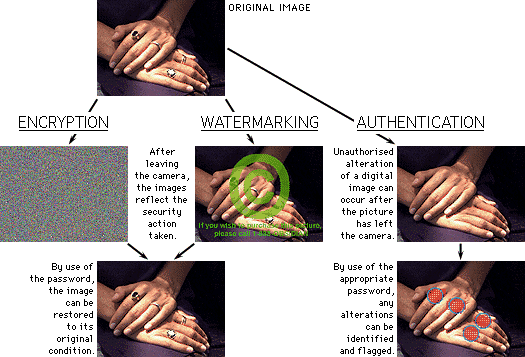TOMORROW'S IMAGING TODAY
DOES OBSIDIAN IMAGING HAVE THE ANSWERS?
by John Henshall
 At the
Police 1996 Digital Imaging Seminar, sponsored by Agfa Gevaert (UK) Ltd and held at West Yorkshire Police Training School, Wakefield, UK, on 19 October 1996. Obsidian Imaging Incorporated's VP Software Eran Steinberg (centre) with organiser Gerry Hancock (left, holding the Obsidian IC/100 camera) and author John Henshall (right).
At the
Police 1996 Digital Imaging Seminar, sponsored by Agfa Gevaert (UK) Ltd and held at West Yorkshire Police Training School, Wakefield, UK, on 19 October 1996. Obsidian Imaging Incorporated's VP Software Eran Steinberg (centre) with organiser Gerry Hancock (left, holding the Obsidian IC/100 camera) and author John Henshall (right).
(Photograph by Barnaby Cox.)
Business use of digital images continues to increase,
though the development of products is often haphazard. Major companies spend
millions of dollars developing digital products only to lob them into the
marketplace, hoping to obtain sales and get feedback from the uses they
see them being put to. Someone uses the camera to photograph houses for
sale, so the manufacturer writes down 'real estate' as an application. Someone
else uses the camera to photograph damage to a car, so the manufacturer
writes down 'insurance loss adjustment'. With a bit of luck, some of the
applications might be profitable.
Obsidian Imaging do not leave it to chance. They put a small computer
inside the digital camera, making it work to assist them. This ensures that
the camera becomes the servant of the application, instead of the other
way round.
THE ANSWER TO IMAGE TAMPERING
There is great scepticism about the integrity of digital imaging because
of scares about digital manipulation. It is often impossible to prove that
images have not been manipulated and this is a major concern for police
and lawyers. Insurance companies suffer from a lot of internal fraud - it
would be easy for a crooked loss adjuster to have a friend who has image
manipulation skills exaggerate the damage, then cook up a deal with the
repairers.
Obsidian Imaging's answer to image tampering is authentication by the
creation of an image signature within the camera at the time of taking the
picture. This removes any possibility of subsequent tampering, for the authentication
travels with the image and Obsidian's software is able to compare any subsequent
copy of the image with the original and detect alteration. A cross-hatch
grid shows where an image has been altered. Incredibly, no other manufacturer
does this.
The system also allows for encryption and for a watermark to be embedded
in the image, to control unauthorised use. These can be removed by the use
of a password.

WORKFLOW MANAGEMENT
Another Obsidian special is workflow. Most users want to take pictures
and incorporate them into documents and forms easily, without having to
know about such technicalities as SCSI addresses, Photoshop plug-ins or
file formats. They would like to get images into a database, perhaps to
track automobile accident repairs for an insurance company, or a case for
the police force. Such information as date, time and location of incident,
who was involved, needs to be attached to the image. Obsidian software also
allows the addition of graphical annotations - for example to draw the police
chief's attention to a particular part of the crime scene. This information
does not become part of the image - it is an overlay 'floating' above it,
thus preserving the integrity of the image - but it does integrate all the
information into one document.
Cameras with computers built-in could be programmed to react in many
other useful ways. For example a surveillance camera could be programmed
to send images back to a remote location automatically when something in
the scene changes.
Obsidian's new facilities push digital imaging forward way beyond whizzy
technical innovation, to the point where it becomes a valuable practical
tool offering distinct advantages over traditional film-based methods.
This is the real future of imaging. Tomorrow's imaging - today.
Visit the Obsidian Imaging website.
This article first appeared as "John Henshall's Chip Shop" in "The Photographer" magazine
December 1996-January 1997 (combined issue).
IMPORTANT NOTICE
This document is Copyright © 1996 John Henshall. All rights reserved.
This material may only be downloaded for personal non-commercial use. Please
safeguard the future of online publishing by respecting this copyright and
the rights of all other authors of material on the Internet.


 At the
Police 1996 Digital Imaging Seminar, sponsored by Agfa Gevaert (UK) Ltd and held at West Yorkshire Police Training School, Wakefield, UK, on 19 October 1996. Obsidian Imaging Incorporated's VP Software Eran Steinberg (centre) with organiser Gerry Hancock (left, holding the Obsidian IC/100 camera) and author John Henshall (right).
At the
Police 1996 Digital Imaging Seminar, sponsored by Agfa Gevaert (UK) Ltd and held at West Yorkshire Police Training School, Wakefield, UK, on 19 October 1996. Obsidian Imaging Incorporated's VP Software Eran Steinberg (centre) with organiser Gerry Hancock (left, holding the Obsidian IC/100 camera) and author John Henshall (right).